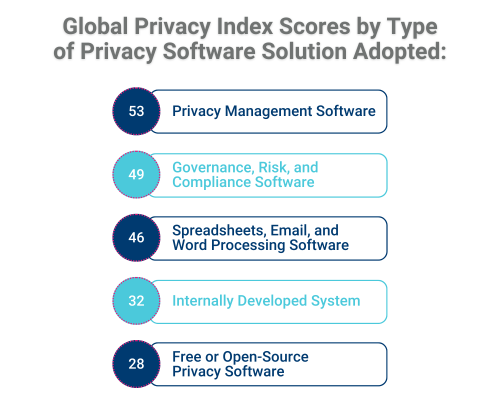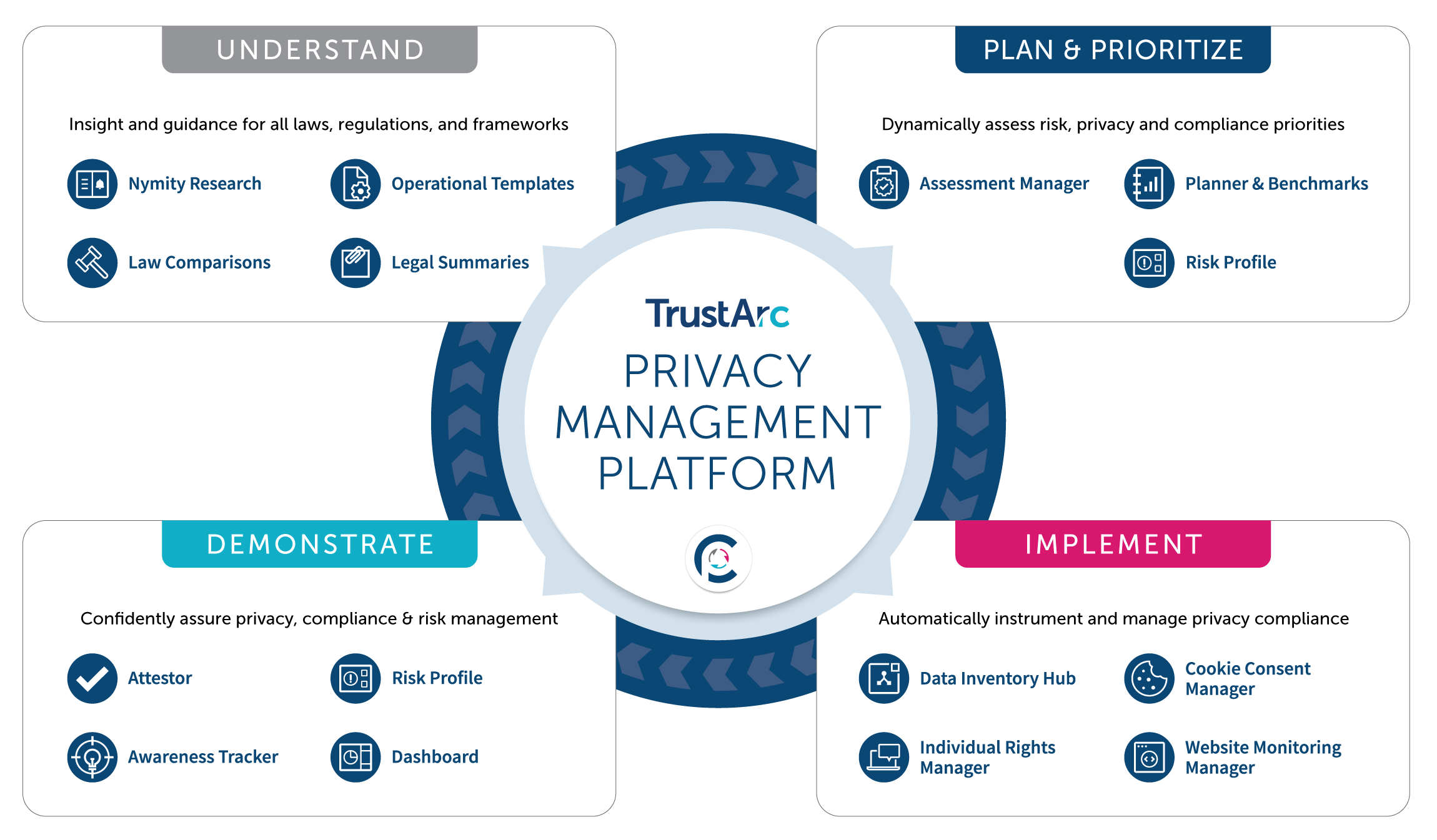When selecting a data privacy automation software for your business, you want to make the right choice. But considering how fast the data privacy industry has grown, it’s likely your first time purchasing software for this purpose.
With the rapid advancement of IoT, Virtual Reality (VR), and Artificial Intelligence (AI), comes the need for greater data responsibility. And regulations are quickly catching up to these new technologies, increasing the need for better privacy programs and data security.
Building a privacy program that minimizes risk to the data subject and your organization requires resources and powerful technology to keep up with the pace of data collection, processing, and requests.
How Do You Know if a Privacy Automation Software Will Meet Your Needs?
Before deciding on the right privacy software, you must understand your business requirements for data privacy.
For example, are there State, Federal, International, or industry-specific regulations that your company must comply with? What types of data are you collecting, processing, or sharing, and what is the risk associated with that information?
Some industries come with greater risks to personal information than others. Especially companies and services that collect health, financial, or other personal information to conduct their operations.
36% of organizations use an open-source solution or spreadsheets and shared documents to start building a privacy program. Trying to scale these solutions usually results in misery, errors, and inconsistency for the privacy team.
It’s at this point that companies start looking for some type of privacy automation software solution. But, before you do, check out these do’s and don’ts of selecting privacy automation software.
What to Do When Selecting Privacy Automation Software
Do Get the Right People Involved
Privacy isn’t the job of a General Counsel, a Chief Privacy Officer, or the Chief Information Security Officer alone. If your company collects data about people, privacy is a part of everyone’s job. In fact, in today’s data-centric world, Heads of Marketing, Strategy, and Data Science are often heavily involved in the privacy technology solution decision.
Before you start researching privacy tech solutions, there are two internal tasks that you should focus on.
- Gather a detailed list of the business functions and their specific requirements to use, process, share, or collect data.
- Outline every business process the potential privacy technology will need to align with to satisfy all requirements you listed in the first task.
- If you haven’t already, at this stage, it’s beneficial to create a high level data map to best understand how data flows in and out of your organization. However, some privacy technology solutions come with this capability.
Understanding the specific requirements and business processes is essential if you want a privacy automation software that will scale with your company. Depending on the nature of your organization, where it’s located, and who your customers and partners are, the people and functions involved in the decision can vary greatly.
Some roles and functions to consider include:
- Information Technology
- Cybersecurity
- Legal Counsel
- Marketing, Communications, and Public Relations
- Information Governance and Risk Management
- Business Strategy, Operations, and Data Intelligence
- Sales and Customer Service
- Human Resources
Data is often used heavily in these functional areas to influence strategy, make decisions, and carry out key daily business functions such as marketing, sales, and customer service. Identify the stakeholders with data privacy interests in your organization and involve them early in the privacy technology selection process.
Do Ensure the Laws and Regulations You Need are Included in the Software
Data privacy has become a complex web of regulations regionally and globally. Mix industry into the equation, and the complexity increases. Now add in quickly advancing technology such as IoT and AI, and the potential for new regulations becomes endless.
When vetting privacy automation software, ask which regulations are included and how often new regulations are added. Some privacy technology solutions may be more tailored to specific regions or industries.
Examine your business strategy. Which regions will you expand to? Industries? Will this be covered with the potential solution? Will it automatically identify privacy laws and standards that apply to your company?
The global privacy regulation landscape is anything but stagnant. And you not only need to keep up with the regulations, but you also need to know how if your current practices are enough to comply with new regulations fully. The best privacy automation software will intuitively analyze gaps between your current privacy program and existing regulations.
The more customers you plan to serve, the more important it is to know the regulations you must comply with and how they change. Otherwise, noncompliance with privacy laws can cost your company millions in fines.
At a minimum, the solution you select needs a strong privacy regulation roadmap. With hundreds of privacy regulations across the globe, this isn’t an area you want to skimp due diligence.
Beyond the sheer number of regulations alone are the intricacies of each regulation. For example, some regulations require privacy assessments (and, therefore, data inventories) to be conducted.
Great privacy automation software moves beyond regulations to include essentials for a privacy program. Ask potential solutions providers about privacy and data protection assessments, templates, automatic data inventory population for assessments, GDPR Article 30 reporting capabilities, data subject rights management, and website compliance audits.
Essentially, you’ll want a tool to plan and structure your entire privacy program in one place.
Do Know Which Connections and Integrations You Require
Data has become central to business operations because of its incredible value when well-harnessed. Contrary to popular belief, data protection doesn’t limit the potential value of data. It increases it.
Purchasing, sharing, processing, or using data that doesn’t comply with privacy regulations is a ticking bomb for your organization. It can cost you in fines, loss of trust and customers, and even lead you in the wrong strategic direction. At the very least, it will take a strenuous effort to get that data to a usable state.
Data collected in compliance with privacy regulations is far more valuable than data that violates privacy laws. The transparent use and collection of data builds trust with stakeholders and provides valuable insights that can be relied upon.
To extract data’s value, you’ll want to find privacy software that can connect with common technologies such as Application Programming Interface (API), Customer Relationship Management (CRM) software, Tag Management Systems, and other Marketing, Website, or Customer Success tools you currently use.
Include outlining desired connections and integrations that will be needed from all stakeholders in your privacy automation software selection process.
Do Select a Software that Can Grow with Your Business
You have big plans for your company and privacy isn’t going away. You need software that can scale with your company and keep up with technology and privacy requirements.
Finding the right privacy automation software the first time can help you save big. Mainly because of switching costs. Getting a privacy program up and running takes time and effort. Employees need to learn how to use the software and get the information uploaded into the system.
If you decide to switch privacy automation software providers after your contract ends, you’ll incur all those costs of setting up a new software again. This is often referred to as switching costs – and it’s a primary reason customers stay locked into a product or service even if they aren’t happy.
As you vet different privacy products make sure you learn about their full suite of capabilities, not just what you need today.
Some privacy programs are built for specific purposes only, while others may span all information governance, data inventory and mapping, consent and preferences management, data subject access requests, and even security requirements.
However, don’t be oversold. If you don’t need every add-on a company is offering today, don’t be forced to buy more than you need.
What Not to Do When Selecting Privacy Automation Software
Don’t Assume Automation Will Do Everything
As AI and machine learning become more prevalent there are still misconceptions about what it can accomplish. Even the best privacy automation software needs to be properly set up to work “automatically”.
Expect to do work on the front end to upload your privacy policies and procedures into the software. You’ll also likely need to import existing data inventories, vendors, and records into the system.
One way that vendors can stand apart is in the level of service they provide to help you get started. Ask about the materials and support available to help integrate your existing processes and migrate data into the application.
Will there be any additional fees for onboarding, training, and implementation of the solution you select? Is there 24-hour support?
These are just a few questions you should consider. In general, it’s most helpful to have a clear understanding of what automation does before you assume it has magic powers.
Don’t Be Fooled by Introductory Pricing/Offers that Quickly Increase in the Years to Come
Remember those switching costs from earlier? Some companies may take those costs to a whole new level by offering low or nearly free introductory pricing and then significantly raising your rates in the years to come.
Pay close attention to any contracts and prices you agree to and ask about future costs. Transparency is highly valued in privacy and your vendors should embody the value of transparency as well. If not, take that as a red flag.
Don’t Select a Privacy Automation Software for Another Purpose
Selecting a dual-purpose software solution or one made for a reason other than managing a privacy program might sound good, or even come in at a better cost for your business. But research shows that the type of privacy software solution you adopt matters.

Organizations that adopted privacy management software among other choices scored the highest on TrustArc’s 2022 Global Privacy Index. Solutions such as Governance, Risk, and Compliance (GRC) software, spreadsheets, emails, internally developed systems, and free or open source privacy software all fell short.
If your company is serious about building consumer trust, avoiding penalties and fines, and building a compliant privacy program, select a dedicated privacy automation software solution.
Don’t Buy a Solution that Doesn’t Help You Extract Value from Your Data
Organizations today are collecting all kinds of data. While some of it may be a special class of personal or sensitive data, other data can be used for all sorts of purposes.
As you search for the right privacy automation software, look for a provider that enables you to achieve your business outcomes through data. Using your list of business processes, determine: what outcomes does the company hope to achieve with data?
At a minimum, you need a solution that will have full data inventory, mapping, and management capabilities. This includes everything from your data lifecycles to building data inventory records for DPIAs, and the ability to configure information collected about each type of data.
You’ll also want to pay special attention to the ability to flag high-risk processes and data compliance risks such as sensitivity and geographic location.
Consent and Data Subject Requests (DSR) Management are Crucial Capabilities
The foundation of a complaint data privacy program lies within transparent communication between your business and its consumers. To use their information, you need their consent or permission. And consumers should be able to easily change or withdraw their consent through DSRs.
A complete privacy software solution will include a platform for consent and preference management as well as managing those data subject requests in a timely manner. You’ll want to find a solution that can assign tasks automatically around resolving DSRs, workflows, and access levels in addition to privacy law compliance.
Global laws and regulations heavily influence how consent and preferences are to be managed. This often has a major influence on how marketing, sales, and communications teams connect with their audience.
You need a solution that can automate privacy law compliance and help you manage your data in a profitable way. Be wary of solutions that focus on only one aspect of the data lifecycle. While they may be specialized, they may not help you achieve your business goals.
Take the Next Step to Automated Privacy Program Management
Explore our variety of privacy automation software solutions.

Whether you are looking for a certification or need to build a robust privacy program including assessments, customer consent and preference management, regulatory compliance, and data management, TrustArc provides the right solution to match your needs.








